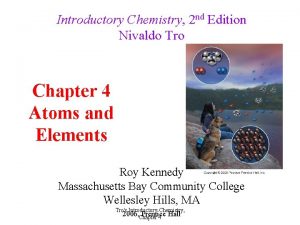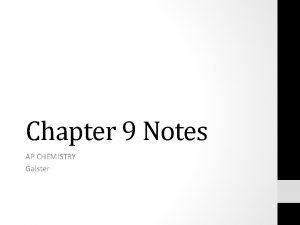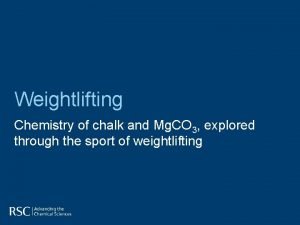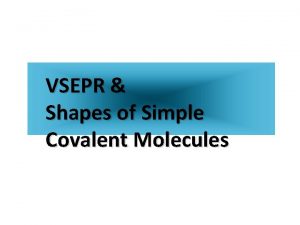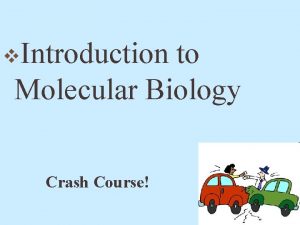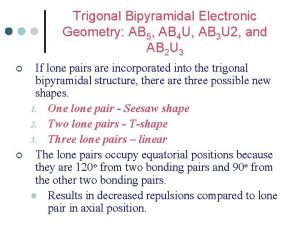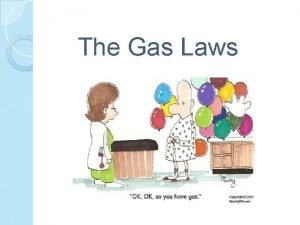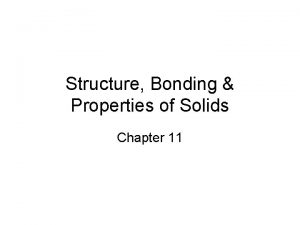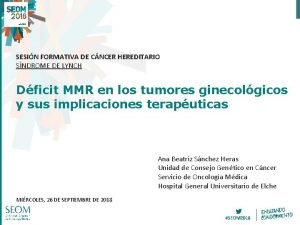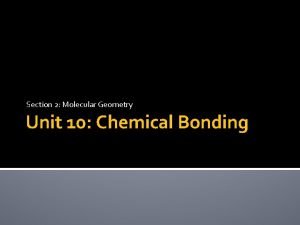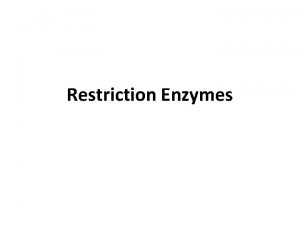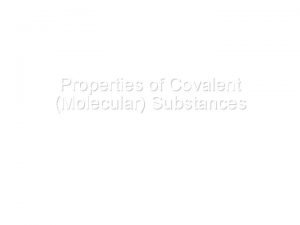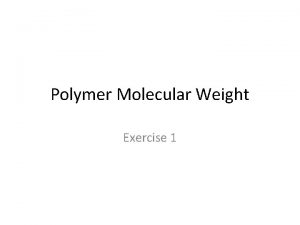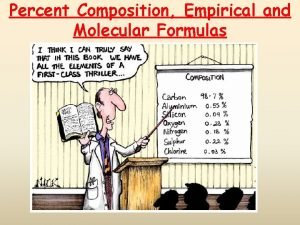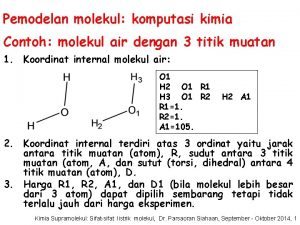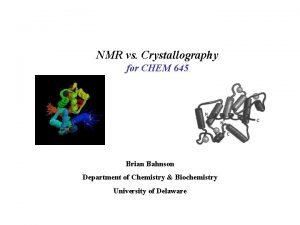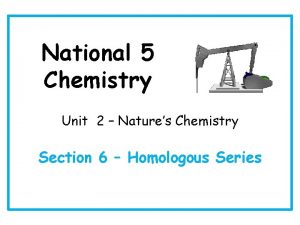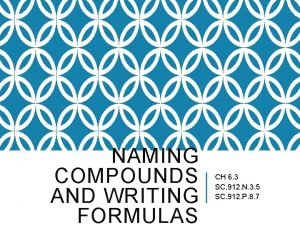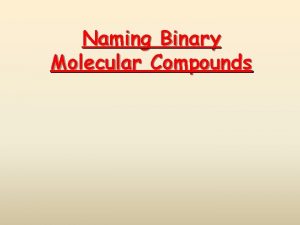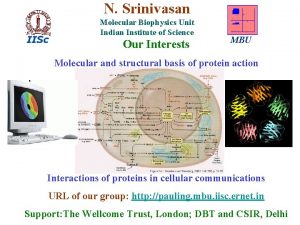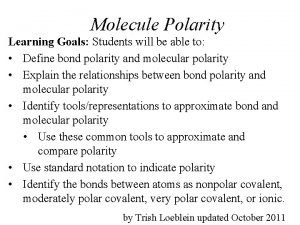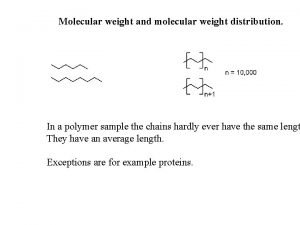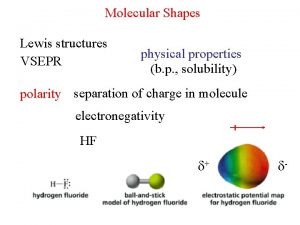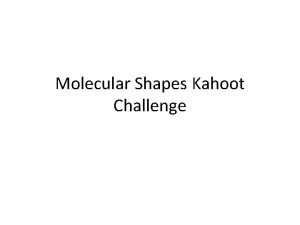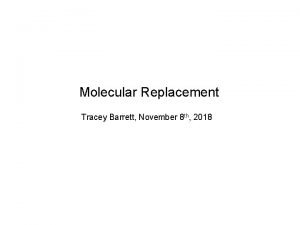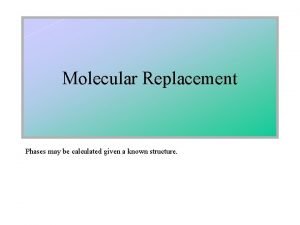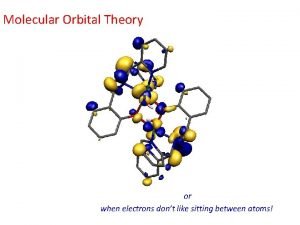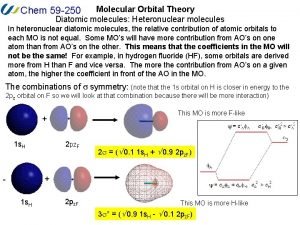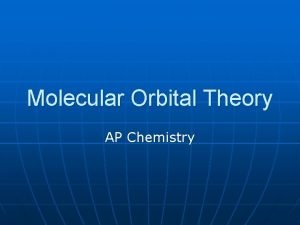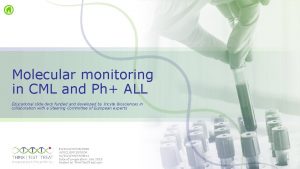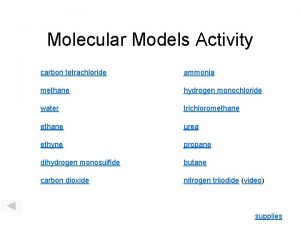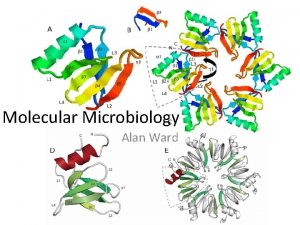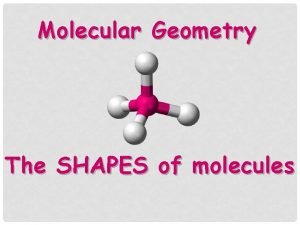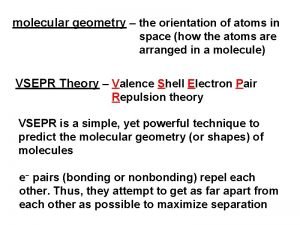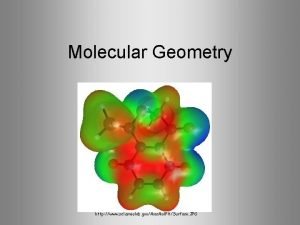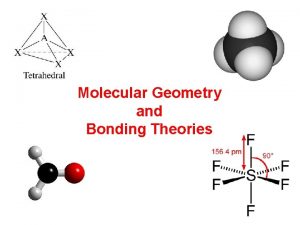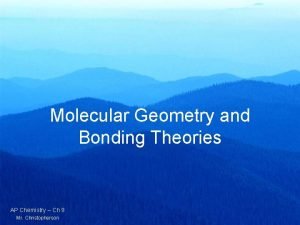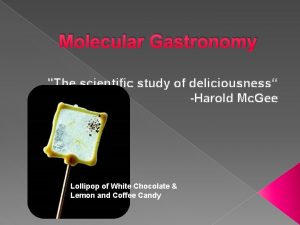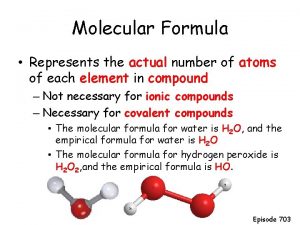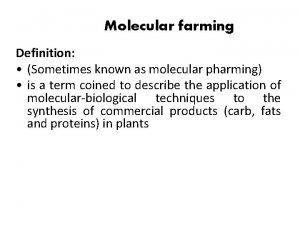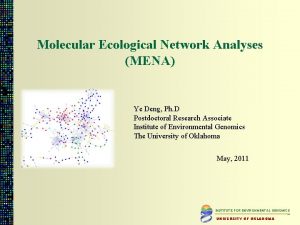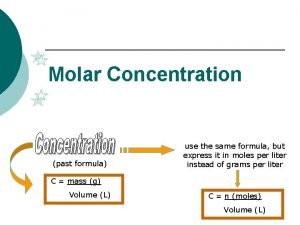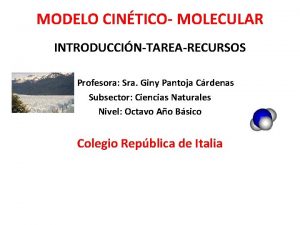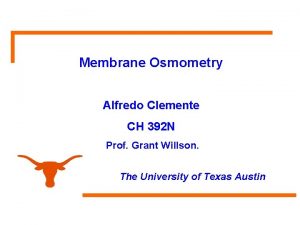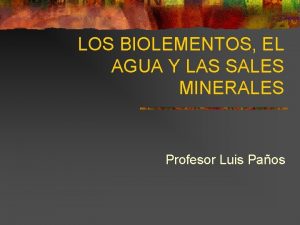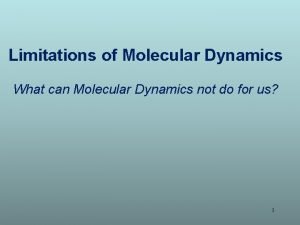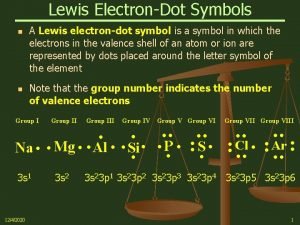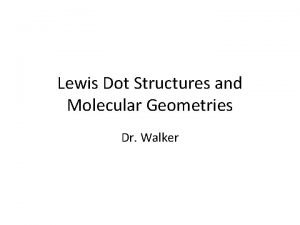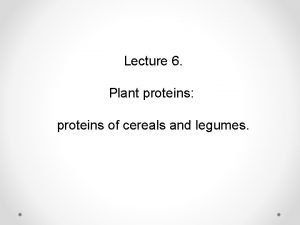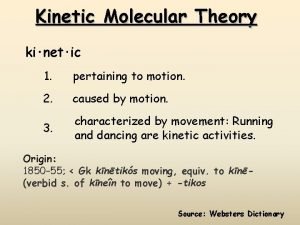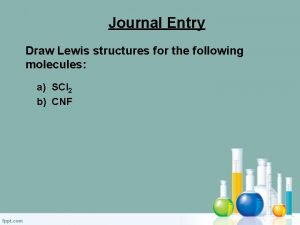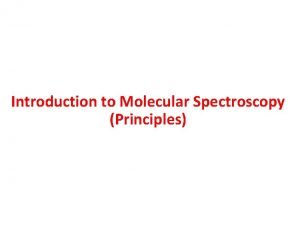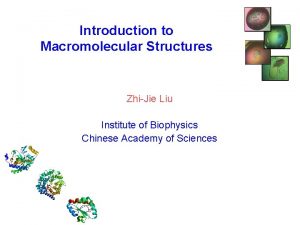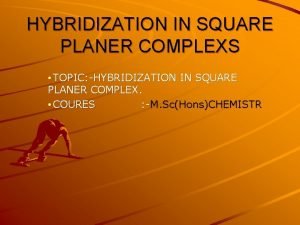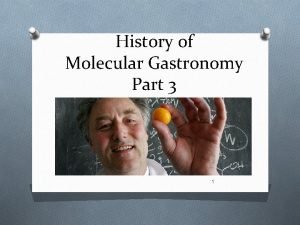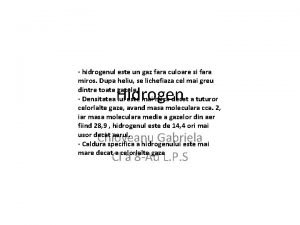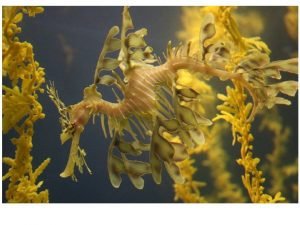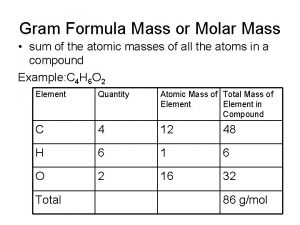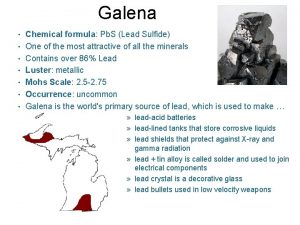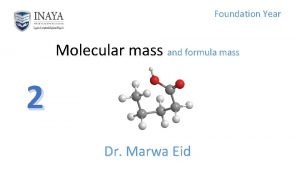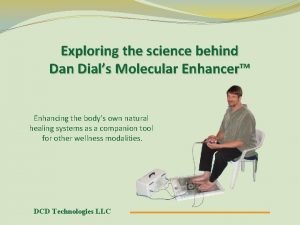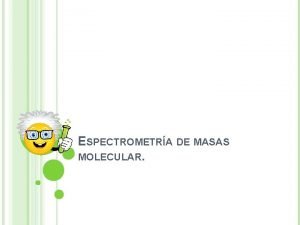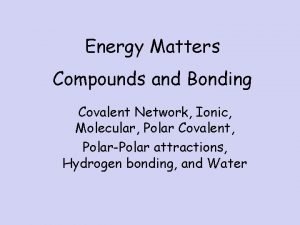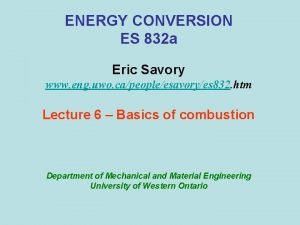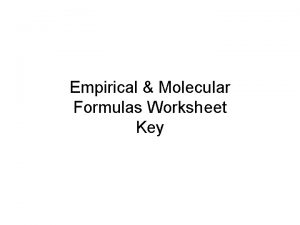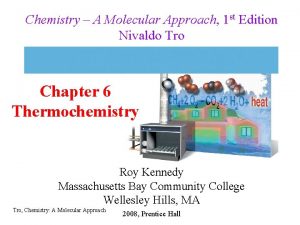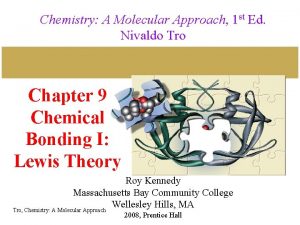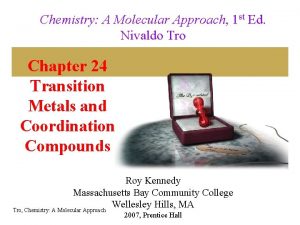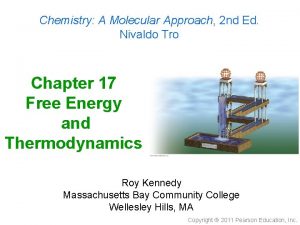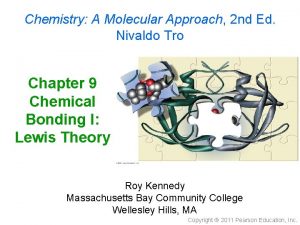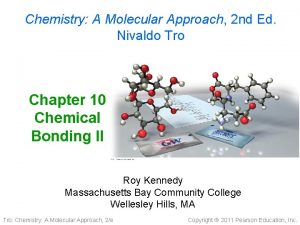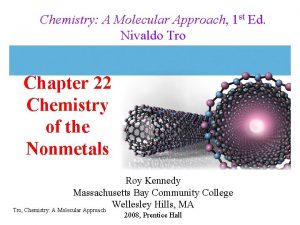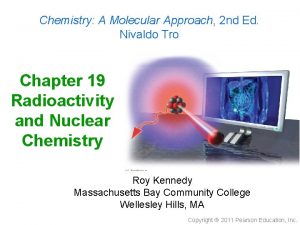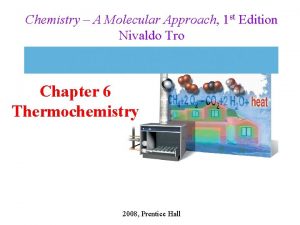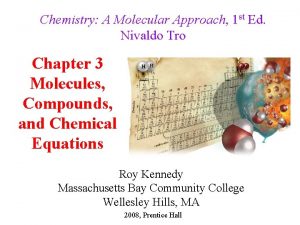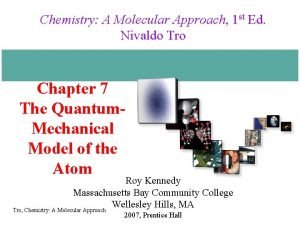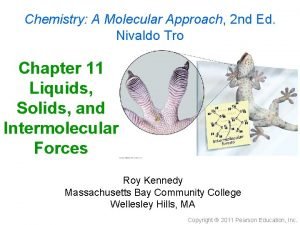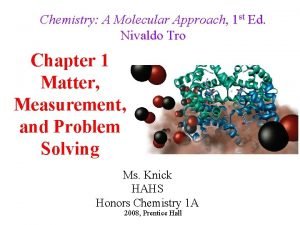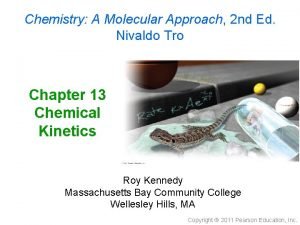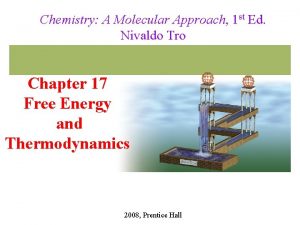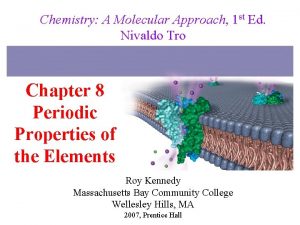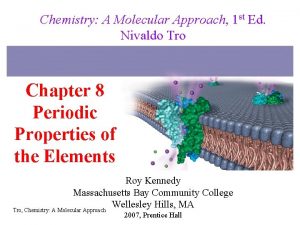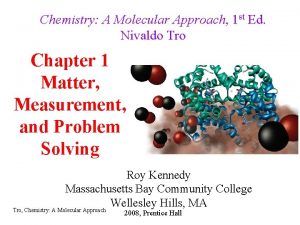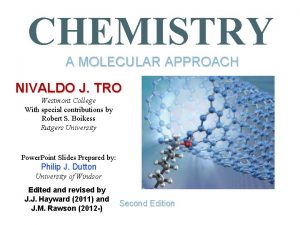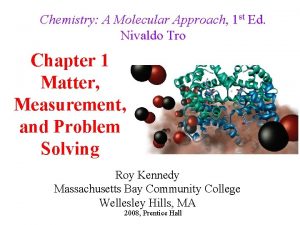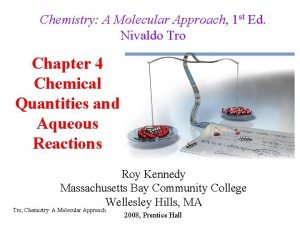Chemistry A Molecular Approach 1 st Ed Nivaldo











































































































- Slides: 107

Chemistry: A Molecular Approach, 1 st Ed. Nivaldo Tro Chapter 1 Matter, Measurement, and Problem Solving Roy Kennedy Massachusetts Bay Community College Wellesley Hills, MA Tro, Chemistry: A Molecular Approach 2008, Prentice Hall

Composition of Matter Atoms and Molecules Scientific Method Tro, Chemistry: A Molecular Approach

Structure Determines Properties • the properties of matter are determined by the atoms and molecules that compose it 1. 2. 3. 4. carbon monoxide composed of one carbon atom and one oxygen atom colorless, odorless gas burns with a blue flame binds to hemoglobin Tro, Chemistry: A Molecular Approach 1. 2. 3. 4. carbon dioxide composed of one carbon atom and two oxygen atoms colorless, odorless gas incombustible does not bind to hemoglobin 3

Atoms and Molecules • atoms ü are submicroscopic particles ü are the fundamental building blocks of all matter • molecules ü two or more atoms attached together Ø attachments are called bonds Ø attachments come in different strengths ü molecules come in different shapes and patterns • Chemistry is the science that seeks to understand the behavior of matter by studying the behavior of atoms and molecules Tro, Chemistry: A Molecular Approach 4

The Scientific Approach to Knowledge • philosophers try to understand the universe by • reasoning and thinking about “ideal” behavior scientists try to understand the universe through empirical knowledge gained through observation and experiment Tro, Chemistry: A Molecular Approach 5

From Observation to Understanding • Hypothesis – a tentative interpretation or explanation for an observation ü falsifiable – confirmed or refuted by other observations ü tested by experiments – validated or invalidated • when similar observations are consistently made, it can lead to a Scientific Law ü a statement of a behavior that is always observed ü summarizes past observations and predicts future ones ü Law of Conservation of Mass Tro, Chemistry: A Molecular Approach 6

From Specific to General Understanding • a hypothesis is a potential explanation for a • single or small number of observations a theory is a general explanation for the manifestation and behavior of all nature ümodels üpinnacle of scientific knowledge üvalidated or invalidated by experiment and observation Tro, Chemistry: A Molecular Approach 7

a test of a hypothesis or theory Scientific Method the careful noting and recording of natural phenomena Tro, Chemistry: A Molecular Approach a tentative explanation of a single or small number of natural phenomena a general explanation of natural phenomena a generally observed natural phenomenon 8

Classification of Matter States of Matter Physical and Chemical Properties Physical and Chemical Changes Tro, Chemistry: A Molecular Approach

Classification of Matter • matter is anything that has mass and occupies • space we can classify matter based on whether it’s solid, liquid, or gas Tro, Chemistry: A Molecular Approach 10

Classifying Matter by Physical State • matter can be classified as solid, liquid, or gas based on the characteristics it exhibits • Fixed = keeps shape when placed in a container • Indefinite = takes the shape of the container Tro, Chemistry: A Molecular Approach 11

Solids • the particles in a solid are packed close together and are fixed in position ü though they may vibrate • the close packing of the particles results • in solids being incompressible the inability of the particles to move around results in solids retaining their shape and volume when placed in a new container, and prevents the particles from flowing Tro, Chemistry: A Molecular Approach 12

Crystalline Solids • some solids have their particles arranged in an orderly geometric pattern – we call these crystalline solids üsalt and diamonds Tro, Chemistry: A Molecular Approach 13

Amorphous Solids • some solids have their particles randomly distributed without any long -range pattern – we call these amorphous solids üplastic üglass ücharcoal Tro, Chemistry: A Molecular Approach 14

Liquids • the particles in a liquid are closely • • packed, but they have some ability to move around the close packing results in liquids being incompressible but the ability of the particles to move allows liquids to take the shape of their container and to flow – however, they don’t have enough freedom to escape and expand to fill the container Tro, Chemistry: A Molecular Approach 15

Gases • in the gas state, the particles • • have complete freedom from each other the particles are constantly flying around, bumping into each other and the container in the gas state, there is a lot of empty space between the particles ü on average Tro, Chemistry: A Molecular Approach 16

Gases • because there is a lot of • empty space, the particles can be squeezed closer together – therefore gases are compressible because the particles are not held in close contact and are moving freely, gases expand to fill and take the shape of their container, and will flow Tro, Chemistry: A Molecular Approach 17

Classification of Matter by Composition • matter whose composition does not change from one sample to another is called a pure substance ü made of a single type of atom or molecule ü because composition is always the same, all samples have the same characteristics • matter whose composition may vary from one sample to another is called a mixture ü two or more types of atoms or molecules combined in variable proportions ü because composition varies, samples have the different characteristics Tro, Chemistry: A Molecular Approach 18

Classification of Matter by Composition 1) made of one type of particle 2) all samples show the same intensive properties Tro, Chemistry: A Molecular Approach 1) made of multiple types of particles 2) samples may show different intensive properties 19

Classification of Pure Substances • substances that cannot be broken down into simpler substances by chemical reactions are called elements ü basic building blocks of matter ü composed of single type of atom Ø though those atoms may or may not be combined into molecules • substances that can be decomposed are called compounds ü chemical combinations of elements ü composed of molecules that contain two or more different kinds of atoms ü all molecules of a compound are identical, so all samples of a compound behave the same way • most natural pure substances are compounds Tro, Chemistry: A Molecular Approach 20

Classification of Pure Substances 1) made of one type of atom (some elements found as multiatom molecules in nature) 2) combine together to make compounds 1) made of one type of molecule, or array of ions 2) molecules contain 2 or more different kinds of atoms 21

Classification of Mixtures • homogeneous = mixture that has uniform composition throughout ü every piece of a sample has identical characteristics, though another sample with the same components may have different characteristics ü atoms or molecules mixed uniformly • heterogeneous = mixture that does not have uniform composition throughout ü contains regions within the sample with different characteristics ü atoms or molecules not mixed uniformly Tro, Chemistry: A Molecular Approach 22

Classification of Mixtures 1) made of multiple substances, whose presence can be seen 2) portions of a sample have different composition and properties 1) made of multiple substances, but appears to be one substance 2) all portions of a sample have the same composition and properties 23

Separation of Mixtures • separate mixtures based on different physical properties of the components üPhysical change Different Physical Property Technique Boiling Point Distillation State of Matter (solid/liquid/gas) Filtration Adherence to a Surface Chromatography Volatility Evaporation Density Centrifugation & Decanting Tro, Chemistry: A Molecular Approach 24

Distillation 25

Filtration 26

Changes in Matter • changes that alter the state or appearance of the • matter without altering the composition are called physical changes that alter the composition of the matter are called chemical changes üduring the chemical change, the atoms that are present rearrange into new molecules, but all of the original atoms are still present Tro, Chemistry: A Molecular Approach 27

Physical Changes in Matter The boiling of water is a physical change. The water molecules are separated from each other, but their structure and composition do not change. Tro, Chemistry: A Molecular Approach 28

Chemical Changes in Matter The rusting of iron is a chemical change. The iron atoms in the nail combine with oxygen atoms from O 2 in the air to make a new substance, rust, with a different composition. Tro, Chemistry: A Molecular Approach 29

Properties of Matter • physical properties are the characteristics of matter that can be changed without changing its composition ücharacteristics that are directly observable • chemical properties are the characteristics that determine how the composition of matter changes as a result of contact with other matter or the influence of energy ücharacteristics that describe the behavior of matter Tro, Chemistry: A Molecular Approach 30

Common Physical Changes • processes that cause • changes in the matter that do not change its composition state changes Dissolving Subliming of Sugar Dry Ice C 12 H 22 O 11(s) Dry Ice üboiling / condensing ümelting / freezing üsubliming • dissolving Tro, Chemistry: A Molecular Approach CO 2(g) CO 2(s) C 12 H 22 O 11(aq) 31

Common Chemical Changes • processes that cause • • • changes in the matter that change its composition rusting processes that release lots of energy burning C 3 H 8(g) + 5 O 2(g) → 3 CO 2(g) + 4 H 2 O(l) Tro, Chemistry: A Molecular Approach 32

Energy Tro, Chemistry: A Molecular Approach

Energy Changes in Matter • changes in matter, both physical and chemical, result • • in the matter either gaining or releasing energy is the capacity to do work is the action of a force applied across a distance ü a force is a push or a pull on an object ü electrostatic force is the push or pull on objects that have an electrical charge Tro, Chemistry: A Molecular Approach 34

Energy of Matter • all matter possesses energy • energy is classified as either kinetic or • • potential energy can be converted from one form to another when matter undergoes a chemical or physical change, the amount of energy in the matter changes as well Tro, Chemistry: A Molecular Approach 35

Energy of Matter - Kinetic • kinetic energy is energy of motion ümotion of the atoms, molecules, and subatomic particles üthermal (heat) energy is a form of kinetic energy because it is caused by molecular motion Tro, Chemistry: A Molecular Approach 36

Energy of Matter - Potential • potential energy is energy that is stored in the matter üdue to the composition of the matter and its position in the universe üchemical potential energy arises from electrostatic forces between atoms, molecules, and subatomic particles Tro, Chemistry: A Molecular Approach 37

Conversion of Energy • you can interconvert kinetic energy and • potential energy whatever process you do that converts energy from one type or form to another, the total amount of energy remains the same üLaw of Conservation of Energy Tro, Chemistry: A Molecular Approach 38

Spontaneous Processes • materials that possess high potential • energy are less stable processes in nature tend to occur on their own when the result is material(s) with lower total potential energy ü processes that result in materials with higher total potential energy can occur, but generally will not happen without input of energy from an outside source • when a process results in materials with less potential energy at the end than there was at the beginning, the difference in energy is released into the environment Tro, Chemistry: A Molecular Approach 39

Potential to Kinetic Energy Tro, Chemistry: A Molecular Approach 40

Standard Units of Measure Tro, Chemistry: A Molecular Approach

The Standard Units • Scientists have agreed on a set of international standard units for comparing all our measurements called the SI units üSystème International = International System Quantity length mass time temperature Tro, Chemistry: A Molecular Approach Unit meter kilogram second kelvin Symbol m kg s K 42

Length • Measure of the two-dimensional distance an object covers ü often need to measure lengths that are very long (distances between stars) or very short (distances between atoms) • SI unit = meter ü About 3. 37 inches longer than a yard Ø 1 meter = one ten-millionth the distance from the North Pole to the Equator = distance between marks on standard metal rod = distance traveled by light in a specific period of time • Commonly use centimeters (cm) ü 1 m = 100 cm ü 1 cm = 0. 01 m = 10 mm ü 1 inch = 2. 54 cm (exactly) Tro, Chemistry: A Molecular Approach 43

Mass • Measure of the amount of matter present in an object ü weight measures the gravitational pull on an object, which depends on its mass • SI unit = kilogram (kg) ü about 2 lbs. 3 oz. • Commonly measure mass in grams (g) or milligrams (mg) ü 1 kg = 2. 2046 pounds, 1 lbs. = 453. 59 g ü 1 kg = 1000 g = 103 g ü 1 g = 1000 mg = 103 mg ü 1 g = 0. 001 kg = 10 -3 kg ü 1 mg = 0. 001 g = 10 -3 g Tro, Chemistry: A Molecular Approach 44

Time • measure of the duration of an event • SI units = second (s) • 1 s is defined as the period of time it takes for a specific number of radiation events of a specific transition from cesium-133 Tro, Chemistry: A Molecular Approach 45

Temperature • measure of the average amount of kinetic energy ü higher temperature = larger average kinetic energy • heat flows from the matter that has high thermal energy into matter that has low thermal energy ü until they reach the same temperature ü heat is exchanged through molecular collisions between the two materials Tro, Chemistry: A Molecular Approach

Temperature Scales • Fahrenheit Scale, °F ü used in the U. S. • Celsius Scale, °C ü used in all other countries • Kelvin Scale, K ü absolute scale Ø no negative numbers ü directly proportional to average amount of kinetic energy ü 0 K = absolute zero Tro, Chemistry: A Molecular Approach 47

Fahrenheit vs. Celsius • a Celsius degree is 1. 8 times larger than a • Fahrenheit degree the standard used for 0° on the Fahrenheit scale is a lower temperature than the standard used for 0° on the Celsius scale Tro, Chemistry: A Molecular Approach 48

Kelvin vs. Celsius • the size of a “degree” on the Kelvin scale is the same as on the Celsius scale üthough technically, we don’t call the divisions on the Kelvin scale degrees; we called them kelvins! üso 1 kelvin is 1. 8 times larger than 1°F • the 0 standard on the Kelvin scale is a much lower temperature than on the Celsius scale Tro, Chemistry: A Molecular Approach 49

Example 1. 2 Convert 40. 00 °C into K and °F • Find the equation that relates Given: the given quantity to the Find: quantity you want to find Equation: Since the equation is solved for the quantity you want to find, substitute and compute 40. 00 °C K K = °C + 273. 15 K = 40. 00 + 273. 15 K = 313. 15 K • Find the equation that relates Given: the given quantity to the Find: quantity you want to find Equation: 40. 00 °C °F • Solve the equation for the quantity you want to find • Substitute and compute •

Related Units in the SI System • All units in the SI system are related to the • • • standard unit by a power of 10 The power of 10 is indicated by a prefix multiplier The prefix multipliers are always the same, regardless of the standard unit Report measurements with a unit that is close to the size of the quantity being measured Tro, Chemistry: A Molecular Approach 51

Common Prefix Multipliers in the SI System Prefix Symbol Decimal Equivalent Power of 10 mega- M kilo- k deci- d 0. 1 Base x 10 -1 centi- c 0. 01 Base x 10 -2 milli- m 0. 001 Base x 10 -3 micro- m or mc 0. 000 001 Base x 10 -6 nano- n 0. 000 001 Base x 10 -9 pico p Tro, Chemistry: A Molecular Approach 1, 000 Base x 106 1, 000 Base x 103 0. 000 000 001 Base x 10 -12 52

• Derived unit Volume ü any length unit cubed • Measure of the amount of space occupied • SI unit = cubic meter (m 3) • Commonly measure solid volume in cubic centimeters (cm 3) ü 1 m 3 = 106 cm 3 ü 1 cm 3 = 10 -6 m 3 = 0. 000001 m 3 • Commonly measure liquid or gas volume in milliliters (m. L) ü 1 L is slightly larger than 1 quart ü 1 L = 1 dm 3 = 1000 m. L = 103 m. L ü 1 m. L = 0. 001 L = 10 -3 L ü 1 m. L = 1 cm 3 Tro, Chemistry: A Molecular Approach 53

Common Units and Their Equivalents Length 1 kilometer (km) 1 meter (m) 1 foot (ft) 1 inch (in. ) Tro, Chemistry: A Molecular Approach = = = 0. 6214 mile (mi) 39. 37 inches (in. ) 1. 094 yards (yd) 30. 48 centimeters (cm) 2. 54 centimeters (cm) exactly 54

Common Units and Their Equivalents Mass 1 kilogram (km) = 2. 205 pounds (lb) 1 pound (lb) = 453. 59 grams (g) 1 ounce (oz) = 28. 35 grams (g) Volume 1 liter (L) 1 U. S. gallon (gal) Tro, Chemistry: A Molecular Approach = = 1000 milliliters (m. L) 1000 cubic centimeters (cm 3) 1. 057 quarts (qt) 3. 785 liters (L) 55

Density Tro, Chemistry: A Molecular Approach

Mass & Volume • two main physical properties of matter • mass and volume are extensive properties üthe value depends on the quantity of matter üextensive properties cannot be used to identify what type of matter something is Øif you are given a large glass containing 100 g of a clear, colorless liquid and a small glass containing 25 g of a clear, colorless liquid - are both liquids the same stuff? • even though mass and volume are individual properties, for a given type of matter they are related to each other! Tro, Chemistry: A Molecular Approach 57

Mass vs. Volume of Brass Tro, Chemistry: A Molecular Approach 58

Volume vs. Mass of Brass y = 8. 38 x 160 140 120 Mass, g 100 80 60 40 20 0 0. 0 2. 0 4. 0 6. 0 8. 0 10. 0 12. 0 14. 0 16. 0 18. 0 Volume, cm 3 Tro, Chemistry: A Molecular Approach 59

Density • Ratio of mass: volume is an intensive property üvalue independent of the quantity of matter • Solids = g/cm 3 ü 1 cm 3 = 1 m. L • Liquids = g/m. L • Gases = g/L • Volume of a solid can be determined by water • displacement – Archimedes Principle Density : solids > liquids >>> gases üexcept ice is less dense than liquid water! Tro, Chemistry: A Molecular Approach 60

Density • For equal volumes, denser • • object has larger mass For equal masses, denser object has smaller volume Heating an object generally causes it to expand, therefore the density changes with temperature Tro, Chemistry: A Molecular Approach 61

Example 1. 3 Decide if a ring with a mass of 3. 15 g that displaces 0. 233 cm 3 of water is platinum • Find the equation that relates the given quantity to the quantity you want to find Given: mass = 3. 15 g volume = 0. 233 cm 3 Find: density, g/cm 3 Equation: • • Since the equation is solved for the quantity you want to find, and the units are correct, substitute and compute Compare to accepted value of the intensive property Density of platinum = 21. 4 g/cm 3 therefore not platinum

Measurement and Significant Figures Tro, Chemistry: A Molecular Approach

What Is a Measurement? • quantitative observation • comparison to an agreed • upon standard every measurement has a number and a unit Tro, Chemistry: A Molecular Approach 64

A Measurement • the unit tells you what standard you are • comparing your object to the number tells you 1. what multiple of the standard the object measures 2. the uncertainty in the measurement • scientific measurements are reported so that every digit written is certain, except the last one which is estimated Tro, Chemistry: A Molecular Approach 65

Estimating the Last Digit • for instruments marked with a scale, you get the last digit by estimating between the marks ü if possible • mentally divide the space into 10 equal spaces, then estimate how many spaces over the indicator mark is Tro, Chemistry: A Molecular Approach 66

Tro, Chemistry: A Molecular Approach 67

Significant Figures • the non-place-holding digits in a reported measurement are called significant figures ü some zeros in a written number are only there to help you locate the decimal point • significant figures tell us the range of values to expect for repeated measurements ü the more significant figures there are in a measurement, the smaller the range of values is Tro, Chemistry: A Molecular Approach 12. 3 cm has 3 sig. figs. and its range is 12. 2 to 12. 4 cm 12. 30 cm has 4 sig. figs. and its range is 12. 29 to 12. 31 cm 68

Counting Significant Figures 1) All non-zero digits are significant ü 1. 5 has 2 sig. figs. 2) Interior zeros are significant ü 1. 05 has 3 sig. figs. 3) Leading zeros are NOT significant ü 0. 001050 has 4 sig. figs. Ø 1. 050 x 10 -3 Tro, Chemistry: A Molecular Approach 69

Counting Significant Figures 4) Trailing zeros may or may not be significant 1) Trailing zeros after a decimal point are significant Ø 1. 050 has 4 sig. figs. 2) Zeros at the end of a number without a written decimal point are ambiguous and should be avoided by using scientific notation Ø if 150 has 2 sig. figs. then 1. 5 x 102 Ø but if 150 has 3 sig. figs. then 1. 50 x 102 Tro, Chemistry: A Molecular Approach 70

Significant Figures and Exact Numbers • Exact numbers have an unlimited number of • significant figures A number whose value is known with complete certainty is exact üfrom counting individual objects üfrom definitions Ø 1 cm is exactly equal to 0. 01 m üfrom integer values in equations Ø in the equation for the radius of a circle, the 2 is exact radius of a circle = diameter of a circle 2 Tro, Chemistry: A Molecular Approach 71

Example 1. 5 Determining the Number of Significant Figures in a Number How many significant figures are in each of the following? 0. 04450 m 4 sig. figs. ; the digits 4 and 5, and the trailing 0 5. 0003 km 5 sig. figs. ; the digits 5 and 3, and the interior 0’s 10 dm = 1 m infinite number of sig. figs. , exact numbers 1. 000 × 105 s 4 sig. figs. ; the digit 1, and the trailing 0’s 0. 00002 mm 1 sig. figs. ; the digit 2, not the leading 0’s 10, 000 m Ambiguous, generally assume 1 sig. fig. Tro, Chemistry: A Molecular Approach 72

Multiplication and Division with Significant Figures • when multiplying or dividing measurements with significant figures, the result has the same number of significant figures as the measurement with the fewest number of significant figures 5. 02 × 89, 665 × 0. 10 = 45. 0118 = 45 3 sig. figs. 5. 892 5 sig. figs. ÷ 4 sig. figs. Tro, Chemistry: A Molecular Approach 2 sig. figs. 6. 10 = 0. 96590 = 0. 966 3 sig. figs. 73

Addition and Subtraction with Significant Figures • when adding or subtracting measurements with significant figures, the result has the same number of decimal places as the measurement with the fewest number of decimal places 5. 74 + 0. 823 + 2. 651 = 9. 214 = 9. 21 2 dec. pl. 4. 8 3 dec. pl. - 1 dec. pl Tro, Chemistry: A Molecular Approach 3. 965 3 dec. pl. = 0. 835 = 2 dec. pl. 0. 8 1 dec. pl. 74

Rounding • 1. 2. • when rounding to the correct number of significant figures, if the number after the place of the last significant figure is 0 to 4, round down ü drop all digits after the last sig. fig. and leave the last sig. fig. alone ü add insignificant zeros to keep the value if necessary 5 to 9, round up ü drop all digits after the last sig. fig. and increase the last sig. fig. by one ü add insignificant zeros to keep the value if necessary to avoid accumulating extra error from rounding, round only at the end, keeping track of the last sig. for intermediate calculations Tro, Chemistry: A Molecular Approach 75

Rounding • rounding to 2 significant figures • 2. 34 rounds to 2. 3 übecause the 3 is where the last sig. fig. will be and the number after it is 4 or less • 2. 37 rounds to 2. 4 übecause the 3 is where the last sig. fig. will be and the number after it is 5 or greater • 2. 349865 rounds to 2. 3 übecause the 3 is where the last sig. fig. will be and the number after it is 4 or less Tro, Chemistry: A Molecular Approach 76

Rounding • rounding to 2 significant figures • 0. 0234 rounds to 0. 023 or 2. 3 × 10 -2 übecause the 3 is where the last sig. fig. will be and the number after it is 4 or less • 0. 0237 rounds to 0. 024 or 2. 4 × 10 -2 übecause the 3 is where the last sig. fig. will be and the number after it is 5 or greater • 0. 02349865 rounds to 0. 023 or 2. 3 × 10 -2 übecause the 3 is where the last sig. fig. will be and the number after it is 4 or less Tro, Chemistry: A Molecular Approach 77

Rounding • rounding to 2 significant figures • 234 rounds to 230 or 2. 3 × 102 übecause the 3 is where the last sig. fig. will be and the number after it is 4 or less • 237 rounds to 240 or 2. 4 × 102 übecause the 3 is where the last sig. fig. will be and the number after it is 5 or greater • 234. 9865 rounds to 230 or 2. 3 × 102 übecause the 3 is where the last sig. fig. will be and the number after it is 4 or less Tro, Chemistry: A Molecular Approach 78

Both Multiplication/Division and Addition/Subtraction with Significant Figures • when doing different kinds of operations with measurements with significant figures, do whatever is in parentheses first, evaluate the significant figures in the intermediate answer, then do the remaining steps 3. 489 × (5. 67 – 2. 3) = 2 dp 1 dp 3. 489 × 3. 37 = 12 4 sf 1 dp & 2 sf Tro, Chemistry: A Molecular Approach 79

Example 1. 6 Perform the following calculations to the correct number of significant figures b) Tro, Chemistry: A Molecular Approach 80

Example 1. 6 Perform the following calculations to the correct number of significant figures b) Tro, Chemistry: A Molecular Approach 81

Precision and Accuracy Tro, Chemistry: A Molecular Approach

Uncertainty in Measured Numbers • uncertainty comes from limitations of the instruments • • • used for comparison, the experimental design, the experimenter, and nature’s random behavior to understand how reliable a measurement is we need to understand the limitations of the measurement accuracy is an indication of how close a measurement comes to the actual value of the quantity precision is an indication of how reproducible a measurement is Tro, Chemistry: A Molecular Approach 83

Precision • imprecision in measurements is caused by random errors üerrors that result from random fluctuations üno specific cause, therefore cannot be corrected • we determine the precision of a set of • measurements by evaluating how far they are from the actual value and each other even though every measurement has some random error, with enough measurements these errors should average out Tro, Chemistry: A Molecular Approach 84

Accuracy • inaccuracy in measurement caused by systematic errors üerrors caused by limitations in the instruments or techniques or experimental design ücan be reduced by using more accurate instruments, or better technique or experimental design • we determine the accuracy of a measurement by • evaluating how far it is from the actual value systematic errors do not average out with repeated measurements because they consistently cause the measurement to be either too high or too low Tro, Chemistry: A Molecular Approach 85

Accuracy vs. Precision Tro, Chemistry: A Molecular Approach 86

Solving Chemical Problems Equations & Dimensional Analysis Tro, Chemistry: A Molecular Approach

Units • Always write every number with its • associated unit Always include units in your calculations üyou can do the same kind of operations on units as you can with numbers Øcm × cm = cm 2 Øcm + cm = cm Øcm ÷ cm = 1 üusing units as a guide to problem solving is called dimensional analysis Tro, Chemistry: A Molecular Approach 88

Problem Solving and Dimensional Analysis • Many problems in chemistry involve using relationships • to convert one unit of measurement to another Conversion factors are relationships between two units ü May be exact or measured • Conversion factors generated from equivalence statements ü e. g. , 1 inch = 2. 54 cm can give Tro, Chemistry: A Molecular Approach or 89

Problem Solving and Dimensional Analysis • Arrange conversion factors so given unit cancels üArrange conversion factor so given unit is on the bottom of the conversion factor • May string conversion factors üSo we do not need to know every relationship, as long as we can find something else the given and desired units are related to Tro, Chemistry: A Molecular Approach 90

Conceptual Plan • a conceptual plan is a visual outline that shows • • the strategic route required to solve a problem for unit conversion, the conceptual plan focuses on units and how to convert one to another for problems that require equations, the conceptual plan focuses on solving the equation to find an unknown value Tro, Chemistry: A Molecular Approach 91

Concept Plans and Conversion Factors • Convert inches into centimeters 1) Find relationship equivalence: 1 in = 2. 54 cm 2) Write concept plan in cm 3) Change equivalence into conversion factors with starting units on the bottom Tro, Chemistry: A Molecular Approach 92

Systematic Approach • Sort the information from the problem ü identify the given quantity and unit, the quantity and unit you want to find, any relationships implied in the problem • Design a strategy to solve the problem ü Concept plan Ø sometimes may want to work backwards Ø each step involves a conversion factor or equation • Apply the steps in the concept plan ü check that units cancel properly ü multiply terms across the top and divide by each bottom term • Check the answer ü double check the set-up to ensure the unit at the end is the one you wished to find ü check to see that the size of the number is reasonable Ø since centimeters are smaller than inches, converting inches to centimeters should result in a larger number Tro, Chemistry: A Molecular Approach 93

Example 1. 7 Convert 1. 76 yd. to centimeters • • Sort information Strategize Given: Find: Concept Plan: Relationships: • • • Follow the concept plan to solve the problem Sig. figs. and round Check 1. 76 yd length, cm yd m cm 1 yd = 1. 094 m 1 m = 100 cm Solution: Round: 160. 8775 cm = 161 cm Check: Units & magnitude are correct

Practice – Convert 30. 0 m. L to quarts (1 L = 1. 057 qt) Tro, Chemistry: A Molecular Approach 95

Convert 30. 0 m. L to quarts • • Sort information Strategize Given: Find: Concept Plan: Relationships: • • • Follow the concept plan to solve the problem Sig. figs. and round Check 30. 0 m. L volume, qts m. L L qt 1 L = 1. 057 qt 1 L = 1000 m. L Solution: Round: Check: 0. 03171 qt = 0. 0317 qt Units & magnitude are correct

Concept Plans for Units Raised to Powers • Convert cubic inches into cubic centimeters 1) Find relationship equivalence: 1 in = 2. 54 cm 2) Write concept plan in 3 cm 3 3) Change equivalence into conversion factors with given unit on the bottom Tro, Chemistry: A Molecular Approach 97

Example 1. 9 Convert 5. 70 L to cubic inches • • Sort information Strategize Given: Find: Concept Plan: Relationships: • • • Follow the concept plan to solve the problem Sig. figs. and round Check 5. 70 L volume, in 3 L m. L cm 3 in 3 1 m. L = 1 cm 3, 1 m. L = 10 -3 L 1 cm = 2. 54 in Solution: Round: 347. 835 in 3 = 348 in 3 Check: Units & magnitude are correct

Practice 1. 9 How many cubic centimeters are there in 2. 11 yd 3? Tro, Chemistry: A Molecular Approach 99

Practice 1. 9 Convert 2. 11 yd 3 to cubic centimeters • • Sort information Strategize Given: Find: Concept Plan: Relationships: • • • Follow the concept plan to solve the problem Sig. figs. and round Check 2. 11 yd 3 volume, cm 3 yd 3 in 3 cm 3 1 yd = 36 in 1 in = 2. 54 cm Solution: Round: 1613210. 75 cm 3 = 1. 61 x 106 cm 3 Check: Units & magnitude are correct

Density as a Conversion Factor • can use density as a conversion factor between mass and volume!! ü density of H 2 O = 1. 0 g/m. L 1. 0 g H 2 O = 1 m. L H 2 O ü density of Pb = 11. 3 g/cm 3 11. 3 g Pb = 1 cm 3 Pb How much does 4. 0 cm 3 of lead weigh? 4. 0 cm 3 Pb x Tro, Chemistry: A Molecular Approach 11. 3 g Pb 1 cm 3 Pb = 45 g Pb 101

Example 1. 10 What is the mass in kg of 173, 231 L of jet fuel whose density is 0. 738 g/m. L? • • Sort information Strategize Given: Find: Concept Plan: Relationships: • • • Follow the concept plan to solve the problem Sig. figs. and round Check 173, 231 L density = 0. 738 g/m. L mass, kg L m. L g kg 1 m. L = 0. 738 g, 1 m. L = 10 -3 L 1 kg = 1000 g Solution: Round: Check: 1. 33 x 105 kg Units & magnitude are correct

Order of Magnitude Estimations • using scientific notation • focus on the exponent on 10 • if the decimal part of the number is less than 5, • • just drop it if the decimal part of the number is greater than 5, increase the exponent on 10 by 1 multiply by adding exponents, divide by subtracting exponents Tro, Chemistry: A Molecular Approach 103

Estimate the Answer • Suppose you count 1. 2 x 105 atoms per second for a year. How many would you count? 1 s = 1. 2 x 105 atoms 1 minute = 6 x 101 102 s 1 hour = 6 x 101 102 min 1 day = 24 101 hr 1 yr = 365 102 days Tro, Chemistry: A Molecular Approach 104

Problem Solving with Equations • When solving a problem involves using an • equation, the concept plan involves being given all the variables except the one you want to find Solve the equation for the variable you wish to find, then substitute and compute Tro, Chemistry: A Molecular Approach 105

Using Density in Calculations Concept Plans: Tro, Chemistry: A Molecular Approach m, V D m, D V V, D m 106

Example 1. 12 Find the density of a metal cylinder with mass 8. 3 g, length 1. 94 cm, and radius 0. 55 cm • • Sort information Strategize Given: Find: Concept Plan: Relationships: • • • Follow the concept plan to solve the problem Sig. figs. and round Check Solution: Check: m = 8. 3 g l = 1. 94 cm, r = 0. 55 cm density, g/cm 3 l, r V m, V d V = π r 2 l d = m/V V = π (0. 55 cm)2 (1. 94 cm) V = 1. 8436 cm 3 Units & magnitude OK
 Introductory chemistry 5th edition nivaldo j. tro
Introductory chemistry 5th edition nivaldo j. tro Introductory chemistry 5th edition nivaldo j. tro
Introductory chemistry 5th edition nivaldo j. tro Nivaldo j. tro introductory chemistry
Nivaldo j. tro introductory chemistry Democritus atomic model diagram
Democritus atomic model diagram Physical state of covalent compounds
Physical state of covalent compounds Ionic covalent metallic
Ionic covalent metallic Zinc oxide + nitric acid → zinc nitrate + water
Zinc oxide + nitric acid → zinc nitrate + water Ap chemistry unit 9 notes
Ap chemistry unit 9 notes Ib chemistry functional groups
Ib chemistry functional groups Organic vs inorganic chemistry
Organic vs inorganic chemistry Is chalk natural or manmade
Is chalk natural or manmade A switch in a datagram network uses
A switch in a datagram network uses Cognitive approach vs behavioral approach
Cognitive approach vs behavioral approach Michael treacy and fred wiersema
Michael treacy and fred wiersema Multiple conflict
Multiple conflict Bandura's reciprocal determinism
Bandura's reciprocal determinism What is research approach
What is research approach Traditional development approach
Traditional development approach Deep learning approach and surface learning approach
Deep learning approach and surface learning approach Vsepr theory predicts
Vsepr theory predicts Trigonal pyramidal bond angle
Trigonal pyramidal bond angle Molecular geometry of pf3
Molecular geometry of pf3 Crash course molecular biology
Crash course molecular biology Molecular level vs cellular level
Molecular level vs cellular level Aniline uv spectrum
Aniline uv spectrum Sf5cl lewis structure
Sf5cl lewis structure Ideal gas law examples
Ideal gas law examples Properties of network covalent solids
Properties of network covalent solids Chapter 14 solids liquids and gases
Chapter 14 solids liquids and gases Trisilicon octaiodide chemical formula
Trisilicon octaiodide chemical formula Clasificacion molecular cancer de endometrio
Clasificacion molecular cancer de endometrio Unit chemical bonding molecular geometry
Unit chemical bonding molecular geometry Molecular scissors
Molecular scissors Molecular rebar design
Molecular rebar design Covalent molecular substances
Covalent molecular substances Empirical formula of haemoglobin
Empirical formula of haemoglobin Number molecular weight
Number molecular weight Dicots
Dicots How to find empirical formula from percent
How to find empirical formula from percent Empirical formula
Empirical formula Water percentage composition
Water percentage composition How to find the empirical formula from percent composition
How to find the empirical formula from percent composition Molecular modelling laboratory
Molecular modelling laboratory Molecular replacement method
Molecular replacement method Shortened structural formula
Shortened structural formula Naming and writing formulas for molecular compounds
Naming and writing formulas for molecular compounds Binary molecular compounds
Binary molecular compounds N srinivasan iisc passed away
N srinivasan iisc passed away Relationship between bond dipoles and molecular dipoles
Relationship between bond dipoles and molecular dipoles Number-average molecular weight
Number-average molecular weight Bp lewis structure
Bp lewis structure Molecular shapes quiz
Molecular shapes quiz Nh3 polar or nonpolar
Nh3 polar or nonpolar Patterson function
Patterson function Patterson
Patterson F-2
F-2 Molecular orbital diagram of heteronuclear diatomic
Molecular orbital diagram of heteronuclear diatomic Li2 molecular orbital diagram
Li2 molecular orbital diagram Cml treatment milestones
Cml treatment milestones Hnhhh
Hnhhh Define microbiology
Define microbiology Vsepr shapes
Vsepr shapes Non polar molecules
Non polar molecules Pf3 molecular geometry
Pf3 molecular geometry Molecular geometry of no3-
Molecular geometry of no3- Molecular geometry and bonding theories
Molecular geometry and bonding theories Abe3 molecular geometry
Abe3 molecular geometry Molecular gastronomy restaurants
Molecular gastronomy restaurants Empirical formula vs molecular formula
Empirical formula vs molecular formula Molecular pharming definition
Molecular pharming definition Molecular ecological network analyses
Molecular ecological network analyses How do you go from molecules to moles
How do you go from molecules to moles Concentration moles equation
Concentration moles equation Modelo cinetico molecular
Modelo cinetico molecular Osmodialysis
Osmodialysis Molecula de sales minerales
Molecula de sales minerales Molecular dynamics limitations
Molecular dynamics limitations Formal charge of hcn
Formal charge of hcn Lewis dot structure and molecular geometry
Lewis dot structure and molecular geometry Gluten molecular structure
Gluten molecular structure Kinetic molecular model of gases
Kinetic molecular model of gases Molecular theory of gases and liquids
Molecular theory of gases and liquids Kinetic molecular theory volume
Kinetic molecular theory volume Scl lewis structure
Scl lewis structure Application of uv visible spectroscopy
Application of uv visible spectroscopy Molecular replacement method
Molecular replacement method Covalent network solid vs molecular solid
Covalent network solid vs molecular solid Bio molecular systems ltd
Bio molecular systems ltd Icl2- shape
Icl2- shape 14-3 human molecular genetics answer key
14-3 human molecular genetics answer key History of molecular gastronomy
History of molecular gastronomy Lichefiaza
Lichefiaza Molecular biology evidence of evolution
Molecular biology evidence of evolution Gram formula mass
Gram formula mass Cl4 geometria molecular
Cl4 geometria molecular Polaridade das moléculas
Polaridade das moléculas Geometria ottaedrica molecole
Geometria ottaedrica molecole Formula of galena
Formula of galena Molecular mass
Molecular mass Formula mass vs molecular mass
Formula mass vs molecular mass Dan dial molecular enhancer
Dan dial molecular enhancer Iodine molecular weight
Iodine molecular weight Fuentes de ionizacion duras y blandas
Fuentes de ionizacion duras y blandas Silicon carbide covalent network
Silicon carbide covalent network Sic covalent bond
Sic covalent bond Carbon dioxide symbol
Carbon dioxide symbol Empirical formula of ethane
Empirical formula of ethane Empirical and molecular formula worksheet
Empirical and molecular formula worksheet


